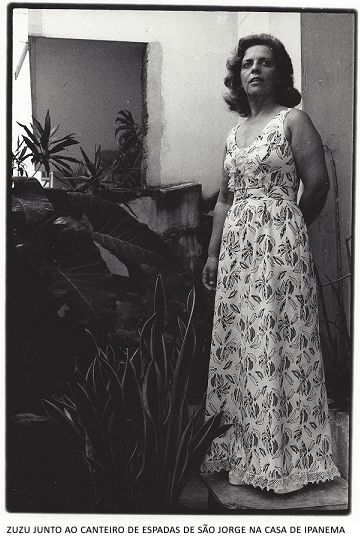Renda-se pays tribute to Zuzu Angel in its 2025 edition
Renda pays special tribute to Zuzu Angel with designers and students developing an exclusive look inspired by the designer's career and work.


Thursday, June 29, 2017

The month of June had strong meaning for Zuzu. Not because she was born on June 5th, 1921, but because of her faith and devotion to St. Anthony. Throughout her professional life, no work was ever done in the atelier on her saint's day. She treated it as a holiday, a day to pay homage to Anthony. Behind the doors of the houses in which she lived, he had always been present in a simple way: a little prayer card, pasted with durex tape. She recited it upon entering and leaving, and taught her children to do the same. She had no expensive, baroque, elaborate images of her saint. She did not mind that. When her father, Pedro Netto, died, she ran to inherit a small St. Anthony image made of clay and his prayer book. Zuzu was not extremely religious, but she had great faith in St. Anthony. She also had a lot of faith in Our Lady of the Conception. She had her image on the head of her bed, but St. Anthony was had her heart. Her young grandson, João Pedro, who she did not get a change to meet, had his baptism dedicated to St. Peter, and during all of his childhood, an “arraial” was held at their house in Usina, which houses Casa Zuzu Angel de Memória da Moda do Brasil today, where a beautiful panel of tiles inspired by St. Anthony protects the fountain’s patio.
June 5th, Zuzu’s date of birth was chosen as the Day of the Environment. A significant date. Zuzu was all about the environment. Her humor, her creativity, her daily life had the nature around her as roots. After the strom, she would put the children in the back seat of her Beetle, and drive around Lagoa Rodrigo de Freitas, in Ipanema, with her windows open. She would take deep breaths to inhale the chlorophyll, and she would admire "the little hills, look, children," and return to her atelier invigorated. At other times, she would make the trip to and from the beach, from Leblon to Leme, or up Avenida Niemeyer, and described much all of this amazed this girl from Minas. She would then go past Túnel Novo, arriving at Copacabana Beach. When she arrived in the city and felt “the ocean smell of Rio de Janeiro” for the first time.
The house was always covered in plants, and her plants were always as lush and happy as she was. She claimed her powers came from nature. She did not spare the protection of the dumbcanes (In Brazil, Comigo-ninguém-pode). The snake plant (known in Brazil as Espada de São Jorge) was always present at the entrance, in two or more pots, still dared to flourish – which was exceptional, considering the plant’s nature. My mother loved plants, and they loved my mother. She also picked them for their beauty. Flamingo-lilies, several ferns, black maidenhair ferns and a dangerous Aveloz, that always made her warn her children: "This plant gives out a milk that could blind you, so don’t play with it." This strange plant, known by many names - milkbush, pencil tree, kayu patah tulang, kayu urip, mentulang, paching tawa, tikel balung - was the permanent and only danger to prowl our childhood: If the milk that poured from one of those thin pencil-like green branches ever dripped into our eyes, we would lose our sight! Whenever we broke twig, we would run to wash our hands. I always wondered why my mother, who was ever so careful, left us at the mercy of that evil plant. Maybe it had powers to protect and cure... Shockingly enough, an American researcher discovered that, yes, it could be used on treatments for warts or even cancer! Oh, its scientific name is Euphorbia Tirucalli.
From the flamboyant, on the flowerbed between the wall and the house, flowers never ceased to flourish, pods loaded with seeds were always falling from the trees, and we used to play swords with them. Zuzu was proud: "My flamboyant."
Due to its symbolism, June always has priority in choosing dates that honor Zuzu Angel. Occasionally, or in a planned manner, tributes usually take place in June. It was when she received the Zuzu Angel Award at the Legislative Assembly of Rio de Janeiro, it was when exhibitions of her designs were held, when she got an homage at the Google Doodle website on her 93rd birthday, not to mention the opening of Casa Zuzu Angel for researchers this June 2017, and the launch of this Website.
Zuzu's June anniversaries reminds us of our mission to keep her memory alive.
Renda pays special tribute to Zuzu Angel with designers and students developing an exclusive look inspired by the designer's career and work.
Renda pays special tribute to Zuzu Angel with designers and students developing an exclusive look inspired by the designer's career and work.
O Grupo Oliwer Martino, liderado por Marlos Oliwer, lançou em 25 de abril a coleção de óculos “Zuzu Angel: Olhares de Liberdade” uma coleção autoral da marca de óculos Oliwer Martino, e também inaugurou uma exposição homônima na Praça Central do Brasil, em Curvelo.
On April 25, 2025, Curvelo/MG made history in Brazilian fashion by hosting the first edition of the Zuzu — Olhares de Liberdade event.